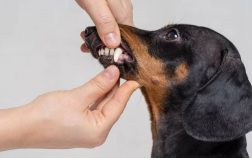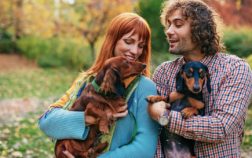Have you ever wondered why dachshunds, those adorable and compact furry friends, seem to struggle when it comes to jumping? It turns out that there is a logical explanation behind this phenomenon. Dachshunds have a unique body structure that is a product of their breeding history and has a significant impact on their ability to jump with ease. In this article, we will explore the reasons why dachshunds can’t jump like their canine counterparts and unravel the science behind their distinctive physique. So, if you’re curious to know why these charming little dogs can’t quite take flight, read on. You’re about to discover some fascinating facts about dachshunds and their jumping challenges.
Physical Limitations of Dachshunds
Short legs
One of the most noticeable physical traits of dachshunds is their short legs. It’s easy to understand why this would pose a challenge when it comes to jumping. With shorter legs, dachshunds simply do not have the same natural ability to propel themselves into the air as other breeds. Their shorter stature limits their vertical reach, making it difficult for them to achieve the height required for successful jumps.
Long body
In addition to their short legs, dachshunds also have a long body. While their elongated shape makes them unique and charming, it presents a hindrance when it comes to jumping. The longer body structure of dachshunds puts strain on their muscles and joints, making it harder for them to generate the power and balance necessary for jumping.
Weak hindquarters
Dachshunds are not known for having strong hindquarters, which further contributes to their difficulty in jumping. The lack of muscle mass in their hind legs reduces their jumping ability and stability. Dachshunds rely heavily on their front legs for support, but the weaker hindquarters make it challenging for them to push off the ground and propel themselves upwards.

The Impact of Anatomy on Jumping Ability
Lack of leverage
Due to their short legs and long body, dachshunds lack the leverage needed to generate enough force for an efficient jump. Leverage plays a crucial role in jumping as it allows dogs to utilize their legs and body weight to push off the ground and propel themselves into the air. Unfortunately, the anatomy of dachshunds does not provide them with the leverage necessary for powerful jumps.
Limited range of motion
Another factor that affects the jumping ability of dachshunds is their limited range of motion. The elongated shape of their body restricts their flexibility, particularly in the spine. This restricted range of motion hampers their ability to extend their bodies fully and generate the necessary momentum for jumping. The lack of flexibility can also increase the risk of injuries to their spine and muscles when attempting to jump.
Risk of Injuries
Spinal problems
Dachshunds are prone to spinal problems, which can be exacerbated by attempting jumps. Their long body puts strain on their spinal column, making them more susceptible to intervertebral disc disease and herniated discs. Jumping can cause sudden and jarring movements that can further compress and damage these delicate spinal structures. It is important to be cautious and attentive to your dachshund’s limitations to prevent spinal injuries.
Muscle strains
The combination of short legs and a long body in dachshunds can strain their muscles when attempting to jump. Their muscles, particularly in the hindquarters and back, may not be adequately developed to handle the stress of jumping. This can lead to muscle strains and sprains, causing discomfort and potential long-term issues. Regular exercise and gradual strengthening can help minimize the risk of these muscle-related injuries.

Falls
Due to their physical limitations, dachshunds are also more prone to falls when attempting jumps. Their shorter legs and weaker hindquarters make it challenging for them to land safely and maintain balance upon landing. This increases the risk of falls, which can result in fractures or other types of injuries. It is crucial to provide a safe environment for your dachshund and avoid situations that may lead to falls or accidents.
Alternative Methods of Moving
Scurrying
While dachshunds may not excel at jumping, they have an innate ability to scurry and move quickly on the ground. Their short legs and elongated body allow them to navigate through tight spaces and burrow with ease. Scurrying is a natural and efficient form of movement for dachshunds, and it can be an alternative to jumping when it comes to exploring their surroundings or playing.
Burrowing
Dachshunds are skilled burrowers, thanks to their hunting heritage. Their unique body shape allows them to dig and burrow through soil or blankets effortlessly. Instead of relying on jumping, dachshunds can utilize their burrowing instincts to access higher surfaces by climbing up ramps or using stairs. Providing opportunities for your dachshund to utilize their burrowing skills can be a safe and alternative way for them to reach higher areas.
Training Considerations
Gentle exercises
When it comes to exercise, it is important to take into account the physical limitations of dachshunds. Engaging in gentle exercises, such as short walks or controlled play sessions, can help maintain their overall fitness without putting excessive strain on their joints or muscles. By focusing on low-impact activities, you can provide your dachshund with the necessary exercise while reducing the risk of injuries associated with jumping.
Proper warm-up
Before engaging in any physical activity, it is crucial to warm up your dachshund properly. This is especially important given their susceptibility to muscle strains and sprains. A warm-up routine that includes stretching exercises and gradual movements can help prepare their muscles and joints for the activity ahead. This can minimize the risk of injuries and ensure a more comfortable and enjoyable exercise experience for your dachshund.
Avoiding high jumps
Considering the physical limitations of dachshunds, it is advisable to avoid high jumps altogether. Overextending their bodies to reach for higher surfaces can lead to injuries or exacerbate existing ones. Instead, providing lower surfaces, ramps, or steps can allow your dachshund to access elevated areas safely. It’s important to remember that preventing injuries is always better than attempting to treat them, so always prioritize your dachshund’s safety.
Assistance Devices
Ramps
Ramps can be a valuable assistance device for dachshunds, especially when it comes to navigating stairs or reaching elevated areas. With their shorter legs and long body, climbing stairs can be arduous and risky for dachshunds. A ramp provides a gentle incline that enables them to access higher surfaces safely and with less strain on their bodies. Using ramps as an alternative to jumping can help protect their joints and minimize the risk of falls or injuries.
Steps
In addition to ramps, providing steps is another helpful assistance device for dachshunds. Steps offer a series of smaller surfaces that make it easier for dachshunds to ascend or descend from elevated areas. By breaking the height into smaller increments, dachshunds can utilize their scurrying abilities to climb or descend with greater ease and less strain on their bodies. Steps are particularly beneficial for dachshunds with mobility issues or those recovering from injuries.
Health Concerns
Obesity
Due to their physical limitations and predisposition to spinal problems, it is essential to maintain a healthy weight for dachshunds. Obesity can exacerbate the strain on their joints, muscles, and spine, increasing the risk of injuries or worsening existing conditions. Providing a balanced and portion-controlled diet, along with regular exercise, can help prevent obesity and keep your dachshund in optimal health.
Poor circulation
The compacted anatomy of dachshunds, with their short legs and long bodies, can cause poor circulation in certain areas of their bodies. This can result in discomfort and potential health issues. Regular exercise and massaging techniques, tailored to the specific needs of dachshunds, can help improve circulation and alleviate any discomfort associated with poor blood flow.
Muscle atrophy
As dachshunds age or experience limitations in their mobility, they may be prone to muscle atrophy. Lack of exercise and limited movement can cause their muscles to weaken and shrink. Regular exercise routines, including low-impact activities, can help maintain muscle strength and prevent muscle atrophy. Additionally, consulting with a veterinarian or canine physical therapist can provide guidance on targeted exercises to address specific muscle groups.
Environmental Adaptations for Dachshunds
Stair gates
Implementing stair gates within your home can serve as a protective measure for dachshunds. Due to their risk of falls and spinal injuries, restricting access to areas with stairs can minimize the likelihood of accidents. Stair gates provide a physical barrier that prevents your dachshund from attempting to climb or descend stairs, ensuring their safety and reducing the need for jumps.
Low beds or furniture
Considering the limitations in their jumping ability, providing low beds or furniture can make it easier for dachshunds to access comfortable resting spots. Lower surfaces that are within their reach enable them to independently navigate their environment without straining their bodies or relying on assistance. By offering accessible resting areas, you can enhance their comfort and reduce the risk of falls or injuries associated with jumping.
Diet and Exercise
Balanced diet
Maintaining a balanced diet is crucial for the overall health and well-being of dachshunds. Providing them with high-quality dog food that meets their nutritional needs is essential. Dachshunds require a diet that supports their joints, muscles, and overall mobility. Consult with your veterinarian to determine the appropriate portion sizes, as overfeeding can lead to excessive weight gain and further strain their already vulnerable anatomy.
Regular walks
While dachshunds may not be natural jumpers, they still require regular exercise to keep them physically and mentally stimulated. Short walks are an excellent form of exercise for dachshunds, as they allow them to engage their muscles and promote healthy circulation without putting excessive strain on their joints or spine. Walking provides an opportunity for them to explore their surroundings and fulfill their instinctual need for mental stimulation.
Supportive Measures
Physical therapy
Engaging in physical therapy sessions can greatly benefit dachshunds with physical limitations, injuries, or post-surgical recovery needs. Physical therapy, under the guidance of a certified professional, can help strengthen their muscles, improve range of motion, and alleviate discomfort. Targeted exercises and massage techniques can be customized to address specific areas of concern and enhance their overall mobility.
Supplements
In some cases, supplements may be recommended to support the joint and muscle health of dachshunds. Omega-3 fatty acids, glucosamine, and chondroitin are commonly used supplements that can help reduce inflammation and promote joint health. However, it is important to consult with your veterinarian before introducing any supplements to ensure they are appropriate for your dachshund’s specific needs.
Understanding the physical limitations of dachshunds is crucial for providing them with a safe and comfortable environment. By implementing alternative methods of movement, such as scurrying and burrowing, and utilizing assistance devices like ramps and steps, you can help your dachshund navigate their surroundings more easily.
Training considerations, including gentle exercises, proper warm-up routines, and avoidance of high jumps, can minimize the risk of injuries. Health concerns such as obesity, poor circulation, and muscle atrophy should be addressed through a balanced diet, regular exercise, and supportive measures like physical therapy and supplements.
By making environmental adaptations, such as using stair gates and providing low furniture, you can create a safe and accessible living space for your dachshund. Remember to always consult with a veterinarian for personalized advice to ensure your dachshund’s specific needs are met. With the right care and understanding, you can help your dachshund lead a happy and comfortable life, regardless of their physical limitations.




